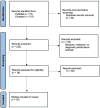Diagnostic Accuracy of Artificial Intelligence for Detection of Meniscus Pathology on Magnetic Resonance Imaging: A Systematic Review
- PMID: 41069890
- PMCID: PMC12506815
- DOI: 10.7759/cureus.91832
Diagnostic Accuracy of Artificial Intelligence for Detection of Meniscus Pathology on Magnetic Resonance Imaging: A Systematic Review
Abstract
Meniscus tears can be difficult to diagnose on magnetic resonance imaging (MRI) due to the various types of tears. As artificial intelligence (AI) continues to advance, it could serve as a valuable tool that assists physicians with diagnostic accuracy and efficiency. The purpose of this study was to analyze the performance of AI in diagnosing meniscus tears on MRI using an array of studies and to compare the performance of AI to that of physicians. A literature search was conducted on PubMed and Embase for articles regarding the use of AI for the detection of meniscus tears. AI model, number of MRI studies, sensitivity, specificity, accuracy, AUC, and comparison to physicians encompassed the data that was extracted. A total of 18 studies, comprising 47,621 MRIs, were included in this review. The AUC of these AI models ranged from 0.781 to 0.984, averaging 0.912±0.053. The pooled sensitivity and specificity were 0.831±0.097 and 0.868±0.088, respectively. Three of these studies compared their results to those of 10 radiologists and two orthopedic surgeons. When comparing the sensitivity and specificity of AI models to those of physicians, Cochrane's Q was statistically significant (p < 0.01) with large heterogeneity amongst the two groups (I2 = 84.72%). The results suggest that AI's ability to detect meniscus lesions on MRI was relatively strong. When this performance was compared to that of physicians, the results were comparable, highlighting the potential benefits in a clinical setting.
Keywords: artificial intelligence; machine learning; magnetic resonance imaging; meniscus; meniscus tear.
Copyright © 2025, Giammanco et al.
Conflict of interest statement
Conflicts of interest: In compliance with the ICMJE uniform disclosure form, all authors declare the following: Payment/services info: All authors have declared that no financial support was received from any organization for the submitted work. Financial relationships: Joseph Elsissy, MD declare(s) personal fees from Johnson & Johnson. Consultant. Joseph Elsissy, MD declare(s) personal fees from Arbutus Medical. Consultant. Other relationships: All authors have declared that there are no other relationships or activities that could appear to have influenced the submitted work.
Figures



References
-
- Epidemiology of athletic knee injuries: A 10-year study. Majewski M, Susanne H, Klaus S. Knee. 2006;13:184–188. - PubMed
-
- The burden of meniscus injury in young and physically active populations. Gee SM, Tennent DJ, Cameron KL, Posner MA. Clin Sports Med. 2020;39:13–27. - PubMed
-
- Diagnostic accuracy of MRI in knee meniscus tear and ACL injury. Zhang X, Zhou J, Jin X, Ji Y, Wang K. https://pubmed.ncbi.nlm.nih.gov/37856803/ Altern Ther Health Med. 2024;30:136–139. - PubMed
-
- A prospective study comparing the accuracy of the clinical diagnosis of meniscus tear with magnetic resonance imaging and its effect on clinical outcome. Miller GK. Arthroscopy. 1996;12:406–413. - PubMed
-
- Arthroscopic evaluation of the accuracy of clinical examination versus MRI in diagnosing meniscus tears and cruciate ligament ruptures. Navali AM, Bazavar M, Mohseni MA, Safari B, Tabrizi A. https://pubmed.ncbi.nlm.nih.gov/23496367/ Arch Iran Med. 2013;16:229–232. - PubMed
Publication types
LinkOut - more resources
Full Text Sources
Research Materials
